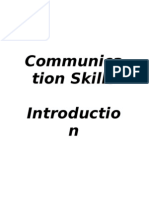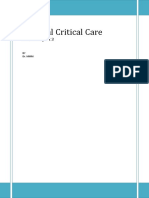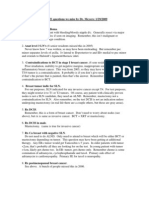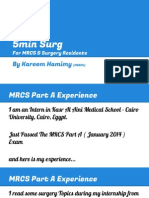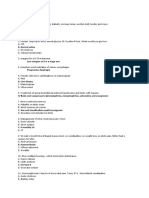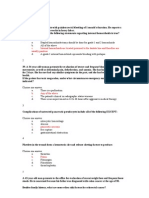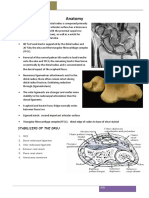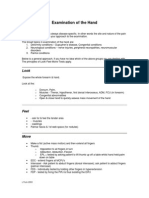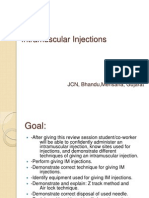0 ratings0% found this document useful (0 votes)
3K viewsImm Toacs
Imm Toacs
Uploaded by
dr_shafiqThe document describes several interactive and static stations from TOACS exams on various medical topics:
1) Stations included scenarios on diabetic foot infection, liver trauma management, small bowel obstruction, thyrotoxicosis with limb ischemia, hydrocele, sigmoid volvulus, peptic ulcer, esophageal cancer and more.
2) Questions assessed knowledge of disease diagnosis, investigations, treatment options and complications.
3) One station required rewriting the correct BLS management algorithm.
Copyright:
© All Rights Reserved
Available Formats
Download as DOCX, PDF, TXT or read online from Scribd
Imm Toacs
Imm Toacs
Uploaded by
dr_shafiq0 ratings0% found this document useful (0 votes)
3K views6 pagesThe document describes several interactive and static stations from TOACS exams on various medical topics:
1) Stations included scenarios on diabetic foot infection, liver trauma management, small bowel obstruction, thyrotoxicosis with limb ischemia, hydrocele, sigmoid volvulus, peptic ulcer, esophageal cancer and more.
2) Questions assessed knowledge of disease diagnosis, investigations, treatment options and complications.
3) One station required rewriting the correct BLS management algorithm.
Original Title
imm toacs
Copyright
© © All Rights Reserved
Available Formats
DOCX, PDF, TXT or read online from Scribd
Share this document
Did you find this document useful?
Is this content inappropriate?
The document describes several interactive and static stations from TOACS exams on various medical topics:
1) Stations included scenarios on diabetic foot infection, liver trauma management, small bowel obstruction, thyrotoxicosis with limb ischemia, hydrocele, sigmoid volvulus, peptic ulcer, esophageal cancer and more.
2) Questions assessed knowledge of disease diagnosis, investigations, treatment options and complications.
3) One station required rewriting the correct BLS management algorithm.
Copyright:
© All Rights Reserved
Available Formats
Download as DOCX, PDF, TXT or read online from Scribd
Download as docx, pdf, or txt
0 ratings0% found this document useful (0 votes)
3K views6 pagesImm Toacs
Imm Toacs
Uploaded by
dr_shafiqThe document describes several interactive and static stations from TOACS exams on various medical topics:
1) Stations included scenarios on diabetic foot infection, liver trauma management, small bowel obstruction, thyrotoxicosis with limb ischemia, hydrocele, sigmoid volvulus, peptic ulcer, esophageal cancer and more.
2) Questions assessed knowledge of disease diagnosis, investigations, treatment options and complications.
3) One station required rewriting the correct BLS management algorithm.
Copyright:
© All Rights Reserved
Available Formats
Download as DOCX, PDF, TXT or read online from Scribd
Download as docx, pdf, or txt
You are on page 1of 6
Station 13 (Static) TOACS April 2013
Picture of diabetic foot with amputated toes
1. Describe findings
2. Investigations
3. Treatment Options
it was picture of a foot wid 4th n 5th toe amputation done , with underlying pus in sole of foot wid
erythema
Station 6 (Interactive)
Scenario of young male with RTA, post liver packing and shifting to ICU. Picture showing monitor.
1. Findings on monitor and interpretation (PB, Pulse, Capnography, and Temp)
2. Further monitoring that will be required ( urinary output CVP and PA cathether Swan Ganz)
3. Abdominal compartment Syndrome definition and effects
4. Principles of damage control laparotomy
5. Transfusion Protocol
The scenario centred around hypovolemic shock and damage control surgery , tested basic knowledge like
Dcs, triad of death , types and classes of shock , abdomen compartment syndrome etc
Station 15 (Static) TOACS April 2013
Picture and History of adult male with 3 month history of vomiting and weight loss. Picture showing a man
with NG tube showing green fluid in bag, CVC in place, X Ray Abdomen showing dilated small bowel loops
with air fluid levels.
1. Acute surgical problem in the scenario
2. Anthropometric measurements to asses nutritional status
3. Method of providing nutrition to this patient
4. Complications of this method
Small bowl obstruction
Station 8 (Interactive) TOACS April 2013
Counselling
Take informed consent of patient for elective laparoscopic cholecystectomy.
His typical question was about probability of him to die
Station 10 (Interactive) TOACS April 2013
Polytrauma patient with GCS 8
1. Management of airway
2. How to confirm proper placement of airway
3. If patient become cyanosed during shifting to CT room, what to do?
4. What may be causes
5. How to check for those causes
6. What will happen if airway not secured
d stress was on word "secure" airway ....d scenario was taken frm atls book , those who hav done atls
wudve had no problem answering the questions , plz read atls manual regarding airway management
"cuffed endotracheal tube " was d answer to a "secure" airway
Station 12 (Interactive)
Patient with h/o thyrotoxicosis with acute onset pain in R lower limb, cold and pulseless limb
1. Diagnosis
2. Further investigations
3. Management Options
4. Size of Fogary Catheter to use
5. Vascular clamps ( bull dog and satinski)
there was also h/o of palpitations which possibly lead to atrial fib leading to limb ischemia due to
embolus
Thyrotoxicosis can be undrlyng cause of AF
Station 9 (Static) TOACS April 2013
Incorrect BLS algorithm given
Please rewrite correct algorithm
i think its in new wash manual..all algorithm are give
Station 2. (Interactive) Logbook
Procedures you did and saw
Discussed axillary clearance in MRM
Discussed surgery for duodenal perforation
Strangulated hernia and abscess
thyriod..how to identified parathyroid peroperatively..how to prevent RLN
Station 1 (Static) TOACS April 2013
Picture of 35 yrs male with recurrent parotid swelling. Scar mark visible.
1. Most likely diagnosis
2. Clinical features to suggest malignancy.
3. What investigations you need to confirm diagnosis
4. Options of treatment
5. What are complications of surgical intervention
Station 14 (Interactive) TOACS April 2013
45 year male with 3 week history of obstructive jaundice and weight loss
1. Further investigations
2. Possible causes
3. Preop Preparation ( vitamin K, hydration for hepatorenal syndrome, antibiotics)
Station 11 (Static) TOACS April 2013
Picture of 1 year old child with hydrocele ( transillumination test on scrotum shown)
1. Diagnosis
2. Differentials
3. Treatment
4. Complications if untreated
Station 7 (Static)
Xray showing sigmoid volvulous in a 50 year old male with 1 day history of abdominal distention, agitation
and constipation.
1. Describe findings
2. Diagnosis
3. Definitive Management Optio
Station 5 (Static)
Endoscopic picture of young male with arthritis and history of NSAID use (Peptic Ulcer)
1. Most likely diagnosis
2. Possible complications
3. How will you manage the complications
Station 4 (Interactive)
Surgical skills
Bowel anastomosis ( end to end)
Station 3 (Static)
Barium swallow of alcoholic and smoker with dysphagia and weight loss showing irregular growth and
narrowing of distal esophagus
1. What are the findings
2. How to confirm the Diagnosis
3. Further investigations and rationale
4. Treatment options
Semihemi Hemi ca oesophagus,gut anastomosis,abdominal compartment syndrome,couselng for lap
chole,trauma n management of airway,hydrocele,acute limb ischemia,obstructive jaundice,acute
intestinal obstruction due to tb abdome nutritional management,diabetic foot,gastric ulcer,log buk
CPSP should Remove one station which was AHA protocol according to 2010. No body could understand the
Question
There was written about taking brachial pulse but we usually take carotid pulse in trauma patient. This
shows that there was rearrange and correction both....anyhow very much confusion about this question
TOACS IMM SURGERY NOV 2012
Epidural haematoma ,
log book
disphragmatic rupture
kesseler s repair
epidural set
couselling for vasetomy of a husband
rectal prolaps
trauma scenerio
phimosis
varicose
gct bone tumour
ingrowing toe nail
pyloric stenosis
TOACS 2012 :
1) Counsell a patient for vasectomy
2) Spinal set
3)Gastric outlet obstruction
4) IGTN
5) gIANT CELL TUmor or osteosarcoma ...pathetic x ray !
6) Extra dural haematoma
7) trauma scenario
rectal prolapse ...waisay i think it was haemorroid
9)diaphragm rupture
10) TPN
11) VEricose veins
12) T TUBE CHOLANGIOGRAM
13) tendon repair
imm oct 9,2012
regarding blast injuries which is appropriate
1 bones are generally spared
2 air filled and gas containng cavities affected early
3 bullets travel in straight line
4 typanic membrane needs more pressure to rupture than lungs
5 exit wounds are larger than entry wounds
2 seems to be right answer as blast injuries are divided into primary blast injuries tht damages air filled
spaces and organs like lung ,ear and GIT ,secondary blast injuries are due to flying objects that strikes
and tertiary blast injuries in which ppl fly and hit other objects due to high explosions , as Ear Injuries
can occur from as little as 5-15 PSI of overpressure ,Lung Injuries occur when the victim experiences
overpressure of greater than 40 pounds per square inch (PSI). so tympanic membrane needs less
pressure and bone are damaged too
IMM Toacs 2010:
Case of Refractory ITP:
Indications of Splenectomy in ITP?
Important considerations in preparation of patient for splenectomy?
Complications and outcome?
Mocks ......infected pancreatic necrosis and infantile hypertrophic pyloric stenosis
A 35 years old man with chronic liver disease presents in the emergency department with history of massive
hematemesis. After resuscitatin , he undergoes upper GI endoscopy which reveals bleeding esophageal
varices.
(a) What initial steps you would take to control the bleeding ?
(b) How will you manage this patient if he stills bleeds after initial steps.
(secure airway . two large bore iv cannula . cross match . ringer lactate . blood transfusion) ,,,, control of
coagulopathy by FFPs. dec platelet count by platelet transfusion , aspiration of stomach by NG tube.
emergency endoscopy . injection or banding.
if still bleeding , 3 options. 1. transfer the patient to radiology suit for TIPSS. 2..pas grastro esophageal
tube like sangstaken blakemore tube . 3. perform emergency laparotomy and make portosystemic
shunts. options are end to end portocavel shunt . side to side porto caval shunt . splenorenal shunt with
splenectomy . mesocaval shunt.distal splenorenal shunt . mortality of surgery is 50%
30april surgery IMM TOACS where i have appeared also. i will sap pray for me too.
INTERACTIVE STATION NO.1.
Q. Your fellow is stung with bee, he developed despnea, fainting , and his pulse was 120 b/mint. now give
answers asked by examiner, then he asked me following questions.
a) what pt is suffering from ?
b) how will u manage this pt immediately when pt falled on ground and how when brought in emergency?
c) why pt developed respiratory problem ?
d) how will u manage respiratory problem?
This patient likely had hypersensitivity reaction. Immidiate management starts with ABC and aims at
adrenaline IV if hemodynamically unstable
naphylaxis due tobee sting.after general assessment of pt ,elevate foot end .pt immediately shifted to er
n intubation if required,o2 inhalation,adrenaline(i/m or i/v).i.v antihistamines,i.v steriods adminstred.n
monitoring of vitals
Type 1 hypersensitivity reaction
If outside hosp then raise legs. Mouth to mouth breathing
In the hosp ett with mechanical ventillation. iv epinephrine. Steroids. Antihistamine. Fluids
Resp problem due to laryngeal edema and bronchospasm
You might also like
- Multiple Choice Questions in Paediatric SurgeryFrom EverandMultiple Choice Questions in Paediatric SurgeryRating: 4 out of 5 stars4/5 (4)
- Procedural SkillsDocument26 pagesProcedural Skillsmrcsexam.iranNo ratings yet
- Communication Skills MRCSDocument37 pagesCommunication Skills MRCSAnirban Ghosh50% (2)
- Common Small Animal Diagnosis An Algorithmic Approach PDFDocument2 pagesCommon Small Animal Diagnosis An Algorithmic Approach PDFAshley0% (5)
- Members DirectoryDocument18 pagesMembers DirectoryRagupathi MNo ratings yet
- IMM Surgery (2019)Document47 pagesIMM Surgery (2019)Umar Farooque100% (2)
- CASE Files SurgeryDocument449 pagesCASE Files SurgeryMarlon Harmsworth33% (3)
- MRCS-B GuidelinesDocument8 pagesMRCS-B GuidelinesMukesh KumarNo ratings yet
- Bazeed MRCS-MergedDocument469 pagesBazeed MRCS-MergedSantosh Achwani100% (1)
- Latest IMM GuidelinesDocument14 pagesLatest IMM GuidelinesUsama1987No ratings yet
- Surgery Viva QuestionsDocument16 pagesSurgery Viva QuestionsChris Lam Cui ShanNo ratings yet
- MRCS Book 1 PDFDocument23 pagesMRCS Book 1 PDFAdaad Ahmad67% (6)
- General Surgery MCQDocument0 pagesGeneral Surgery MCQSara Ehab67% (3)
- 09-Basic Science-Orthobullets2017 PDFDocument241 pages09-Basic Science-Orthobullets2017 PDFdr_shafiq100% (3)
- Aortic Root FinalDocument82 pagesAortic Root FinalMustafa KamalNo ratings yet
- Write Short Notes On:: Important InstructionsDocument1 pageWrite Short Notes On:: Important InstructionsSudhanshuGoyalNo ratings yet
- Absite Review QuestionsDocument81 pagesAbsite Review QuestionsJames JosephNo ratings yet
- Toacs Surgical Trainees 2009 ADocument15 pagesToacs Surgical Trainees 2009 AAnonymous bzHRfZzv100% (1)
- Surgery Toacs APRIL 2012: Hassaan Bari Aga Khan UniversityDocument18 pagesSurgery Toacs APRIL 2012: Hassaan Bari Aga Khan UniversitySyedNo ratings yet
- General Surgery Board-Final Written Exam Blueprint v.1Document3 pagesGeneral Surgery Board-Final Written Exam Blueprint v.1Mohammed S. Al Ghamdi0% (2)
- Surgery & AlliedDocument38 pagesSurgery & Alliedfa202awaNo ratings yet
- ABSITEDocument6 pagesABSITEhp0% (1)
- General Surgery SEQDocument15 pagesGeneral Surgery SEQFatima Arshad100% (1)
- TOACS With KEYDocument25 pagesTOACS With KEYMehwish MughalNo ratings yet
- Iam Free Jan'24 MRCS ADocument4 pagesIam Free Jan'24 MRCS AthanitoNo ratings yet
- Surgical Critical Care For MRCS 3Document132 pagesSurgical Critical Care For MRCS 3Ido EgaziNo ratings yet
- Absite Questions MissedDocument11 pagesAbsite Questions Misseddrmdz3No ratings yet
- (Postgrad Exams) Steve Parker-MRCS Applied Basic Science and Clinical Topics-JP Medical Publishers (2012)Document422 pages(Postgrad Exams) Steve Parker-MRCS Applied Basic Science and Clinical Topics-JP Medical Publishers (2012)Desmond LingNo ratings yet
- Rmu Surgery OspesDocument110 pagesRmu Surgery OspesHumna Younis100% (1)
- Surgery Ospe 322Document322 pagesSurgery Ospe 322fbf50269No ratings yet
- Procedural Skills (Awasir)Document34 pagesProcedural Skills (Awasir)Yousef TaqatqehNo ratings yet
- Pathology Mrcs Notes 1 PDFDocument553 pagesPathology Mrcs Notes 1 PDFdanish balochNo ratings yet
- All in One Golden CPSP QuestionsDocument570 pagesAll in One Golden CPSP QuestionsQuranSunnat100% (2)
- General Surgery Question PapersDocument2 pagesGeneral Surgery Question PaperssoundharyaNo ratings yet
- MCQ Breast Surgery Bordeaux 2010Document9 pagesMCQ Breast Surgery Bordeaux 2010Ismail Evren100% (1)
- General Surgery NuggetsDocument12 pagesGeneral Surgery Nuggetsamna_badar1No ratings yet
- General Surgery Exam QuestionsDocument4 pagesGeneral Surgery Exam QuestionsХаири Даниель33% (3)
- Vascular CasesDocument194 pagesVascular CasesaskjagNo ratings yet
- MRCS Part A PreparationDocument11 pagesMRCS Part A PreparationKareem Waleed Ibrahim Hamimy100% (11)
- Surgery Solved UHS SeqsDocument46 pagesSurgery Solved UHS SeqsMuntaha Javed100% (3)
- Pathology MRCS BDocument77 pagesPathology MRCS BHina MalikNo ratings yet
- Matary MCQ 2011Document197 pagesMatary MCQ 2011Raouf Ra'fat Soliman100% (3)
- Surgery MCQsDocument24 pagesSurgery MCQsKiara Govender100% (2)
- Pediatric Surgery QuizDocument343 pagesPediatric Surgery Quizapi-1983611667% (3)
- Surgery 3 White Part 1Document87 pagesSurgery 3 White Part 1Håíthãm KhãtïßNo ratings yet
- Gyane MCQS 6, 7, 9 Chapter Irfan Masood PDFDocument16 pagesGyane MCQS 6, 7, 9 Chapter Irfan Masood PDFJansher Ali Chohan100% (1)
- MS SurgeryDocument118 pagesMS SurgeryLove watta100% (1)
- Small Intenstine MedCosmos Surgery - MCQDocument29 pagesSmall Intenstine MedCosmos Surgery - MCQMike GNo ratings yet
- Jan 2016+ AnsDocument18 pagesJan 2016+ AnssohamNo ratings yet
- Final Surgery RevisionDocument195 pagesFinal Surgery RevisionteamirNo ratings yet
- Usmle Surgery Mcqs PDFDocument2 pagesUsmle Surgery Mcqs PDFGhadeer Ebraheem75% (4)
- 0.MRCS Part B IntroDocument9 pages0.MRCS Part B Introamila19mdNo ratings yet
- My Revision Timetable 2023Document10 pagesMy Revision Timetable 2023Ebraheam HadiNo ratings yet
- DNB Gen Surgery Old Question Papers 1Document28 pagesDNB Gen Surgery Old Question Papers 1sidorai100% (1)
- April 2017Document12 pagesApril 2017Saryia JavedNo ratings yet
- 6th Year Surgery Final ExamDocument21 pages6th Year Surgery Final Examlinaleen67% (3)
- MCQ Jeddah - Doc (FINAL) 2Document9 pagesMCQ Jeddah - Doc (FINAL) 2Indrajit Barua100% (1)
- MRCS Osce Sample-2 PDFDocument25 pagesMRCS Osce Sample-2 PDFAmmarNo ratings yet
- SURGERY 2019-2008 Regular-Supplementary Chapter Wise Question Papers WBUHS-1 PDFDocument17 pagesSURGERY 2019-2008 Regular-Supplementary Chapter Wise Question Papers WBUHS-1 PDFAditya Barman100% (1)
- Ultimate Comprehensive ABSITE Study Guide1Document125 pagesUltimate Comprehensive ABSITE Study Guide1Steven GodelmanNo ratings yet
- OSCE Surgery LatestDocument97 pagesOSCE Surgery LatestPrasad Hewawasam0% (1)
- MRCS Clinical 3 1Document47 pagesMRCS Clinical 3 1Alexandros Megas100% (1)
- General Pathology Single Best Answers For The MRCSDocument22 pagesGeneral Pathology Single Best Answers For The MRCStahir_the_great2939No ratings yet
- 10 Distal - RadiusDocument69 pages10 Distal - Radiusdr_shafiqNo ratings yet
- Quick Guide On Console Workflow (FDX V8.1) : Effective Date: 10/7/2015 Page 1 of 10Document10 pagesQuick Guide On Console Workflow (FDX V8.1) : Effective Date: 10/7/2015 Page 1 of 10dr_shafiqNo ratings yet
- Fibromyalgia Criteria 1990Document1 pageFibromyalgia Criteria 1990dr_shafiqNo ratings yet
- Examination of The Hand: o o o oDocument5 pagesExamination of The Hand: o o o oGurunadh OrthoNo ratings yet
- Surgery MrcsDocument339 pagesSurgery Mrcsdr_shafiq80% (10)
- 500 SBA Gen SystemicDocument27 pages500 SBA Gen Systemicdr_shafiqNo ratings yet
- ToacsDocument3 pagesToacsdr_shafiqNo ratings yet
- Nilufer Guleyupoglu, MD Recognized As A Professional of The Year by Strathmore's Who's Who Worldwide PublicationDocument2 pagesNilufer Guleyupoglu, MD Recognized As A Professional of The Year by Strathmore's Who's Who Worldwide PublicationPR.comNo ratings yet
- Autism Spectrum DisorderDocument2 pagesAutism Spectrum DisorderMarissa AsimNo ratings yet
- Philippine Counterfeiting Guidelines For ReportingDocument31 pagesPhilippine Counterfeiting Guidelines For ReportingAidee SmithNo ratings yet
- Abstrak Nadia SariDocument2 pagesAbstrak Nadia SariDwi PratiwiNo ratings yet
- UroMax Ultra BrochureDocument3 pagesUroMax Ultra Brochuremaria dolores ramirez roseteNo ratings yet
- 7 Midazozalam Drug StudyDocument3 pages7 Midazozalam Drug Studyshadow gonzalezNo ratings yet
- Questionnaire EndosDocument16 pagesQuestionnaire Endosnhafizah69No ratings yet
- Nurses' Knowledge, Attitude, and Fall Prevention Practices at South Korean Hospitals - A Cross-Sectional SurveyDocument9 pagesNurses' Knowledge, Attitude, and Fall Prevention Practices at South Korean Hospitals - A Cross-Sectional Surveytweet tweetNo ratings yet
- Intramuscular InjectionsDocument29 pagesIntramuscular InjectionsRakersh Patidar100% (4)
- ER-Diagram ExplanationsDocument3 pagesER-Diagram ExplanationsGokay GulsoyNo ratings yet
- Atelektasis: Penyaji: Martvera SDocument20 pagesAtelektasis: Penyaji: Martvera Saidil ilham100% (1)
- Checklist Final Required After Acceptance 07082019Document1 pageChecklist Final Required After Acceptance 07082019Ervin KalraNo ratings yet
- At The Pharmacy: A Dialogue Between A Pharmacist and A CustomerDocument3 pagesAt The Pharmacy: A Dialogue Between A Pharmacist and A CustomerPikm LarashatiNo ratings yet
- hicc_manual_ghDocument203 pageshicc_manual_ghLohith BanothNo ratings yet
- ASCIA Guidelines Acute Management Anaphylaxis 2017 Updated PDFDocument8 pagesASCIA Guidelines Acute Management Anaphylaxis 2017 Updated PDFAyu WahyuniNo ratings yet
- NURS FPX 6214 Assessment 2 Stakeholder MeetingDocument4 pagesNURS FPX 6214 Assessment 2 Stakeholder Meetingjoohnsmith070No ratings yet
- Hypnotherapy +aromatherapy + Laughter Therapy+ ImmuneDocument131 pagesHypnotherapy +aromatherapy + Laughter Therapy+ ImmuneAlaa OmarNo ratings yet
- Contagious Bovine Pleuropneumonia: DR. DK Singh Pathologist, IAASDocument34 pagesContagious Bovine Pleuropneumonia: DR. DK Singh Pathologist, IAASSuraj_SubediNo ratings yet
- Policy and Procedures For Referral of Patients To Higher Level of CareDocument6 pagesPolicy and Procedures For Referral of Patients To Higher Level of CareAngel Mae BaborNo ratings yet
- Chapter 18 Pre-Test: Medical-Surgical Nursing: Concepts & Practice, 3Rd Ed. Susan DewitDocument1 pageChapter 18 Pre-Test: Medical-Surgical Nursing: Concepts & Practice, 3Rd Ed. Susan DewitReakwon AllenNo ratings yet
- Midwifery and Obstetrical Nursing: Course DescriptionDocument36 pagesMidwifery and Obstetrical Nursing: Course DescriptionrenjiniNo ratings yet
- Algoritmo HematuriaDocument282 pagesAlgoritmo HematuriaPatriciaZlamalikNo ratings yet
- Nourene ResumeDocument3 pagesNourene Resumenourene irobeyitneneNo ratings yet
- Med BD Book New 26 Jul 2022Document149 pagesMed BD Book New 26 Jul 2022Abhirup GhoshNo ratings yet
- Resources Guide For Foundation Trainee DoctorsDocument4 pagesResources Guide For Foundation Trainee DoctorsSarina PromthongNo ratings yet
- Bacterial MeningitisDocument2 pagesBacterial MeningitisSinclair Broadcast Group - EugeneNo ratings yet
- Carmen 2022Document242 pagesCarmen 2022Aleiah Jean LibatiqueNo ratings yet


